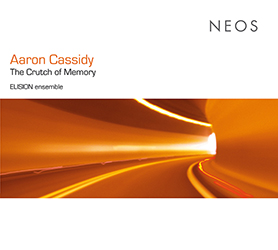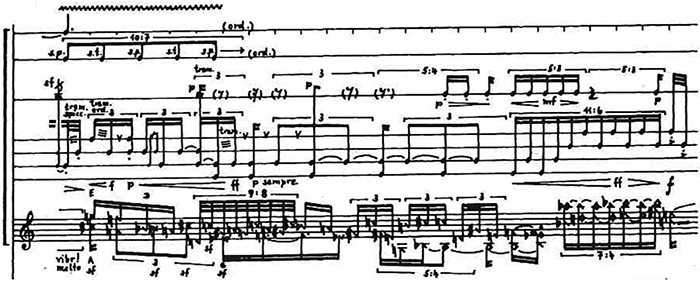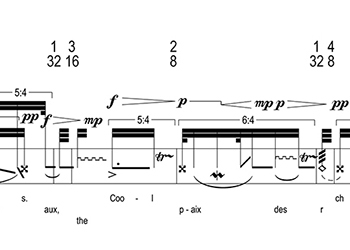
There are times when a composer wins you over instantly, the cogency of their arguments captured in a transparent marriage of sound and idea that’s instantly familiar and welcoming. This has emphatically not been my experience with the music of Aaron Cassidy. Over the last few years, i’ve oscillated around Cassidy’s music with the regularity of a comet, never quite pulled into orbit (or should that be a collision?), but constantly drawn back nonetheless. With the release, a few months ago, of the first CD devoted to his music, i figured it was time to try to pin down my thoughts about what Aaron Cassidy is up to. The CD, The Crutch of Memory, focuses on works for one or two players, encompassing both Cassidy’s earliest music as well as relatively recent pieces, the latest of which is around three years old. Both the spread of output as well as the restricted forces involved make this a superb primer for Cassidy’s work.
To begin to understand his compositional approach, take a look at the score excerpt below, taken from Richard Barrett’s 1988 work for trombone and percussion, EARTH.
At this point, towards the end of the piece, the trombone’s music abruptly bifurcates into two staves, the upper showing the slide positions, the lower showing the harmonics being sounded. This fundamentally undermines the way a trombonist is used to playing, where these two parameters imply each other within conventional notation; yet by ‘decoupling’ those parameters, and destroying their traditional connection, Barrett creates a remarkable effect—which, in context, is both profoundly moving and deeply distressing—that could not have been achieved any other way.
As early as 1969, Xenakis composed what could be described as a step in the direction of ‘decoupling’, the piano part of Synaphaï comprising staves for each finger, thus requiring the pianist to re-conceive their understanding of hand-eye coordination.
But the precedents that have had the most demonstrable impact on Cassidy’s work are the music of Klaus K. Hübler and Frank Cox. Both Cox and Hübler take this decoupling of hitherto seamlessly integrated facets of performance practice to extremes, bringing them into the foreground as malleable parameters in their own right. Hübler’s third string quartet, „Dialektische Phantasie“ (1984), fractures the performance parameters to the extent of requiring multiple staves; in the below example, which shows a short snippet of the second violin’s material, there are staves indicating, among other things, the type of bowing, bow position, bowing rhythms as well as left-hand articulations.
To convey this clearly, Hübler adopts a ‘tablature’ notation, a technique mirrored in the music of Frank Cox, as can be clearly seen in this example from his cello piece Recoil (a work that Ian Pace, at its UK première, described as “surely … the hardest work ever written for a string instrument?”):
Which brings us to Aaron Cassidy, whose own music arises out of precisely this kind of tablature notation. ’Twas not exactly ever thus, though, and the oldest works on the CD are interesting in the way they demonstrate an earlier stage of development. Both metallic dust for amplified bass clarinet (1999) and asphyxia for soprano saxophone (2000) use two staves throughout, labelled ‘mouth’ and ‘fingers’ respectively. That immediately suggests the kind of decoupling spoken of before, but what makes the music rather different from his more recent work is the presence of obvious pitched material, in the form of a voice in the lower stave that is articulated—sometimes sympathetically, usually not—by the upper stave, acted upon and subjected to an unceasing flux of predicaments. Unsurprisingly, these pieces thereby embody elements of the grotesque—Cassidy likens the structure of metallic dust to “twelve (inter-)connected, self-similar vignettes or fragments, as in a maddening maze of twelve seemingly identical rooms, each a different shape and size from the preceding room”—yet it’s immediately apparent that there’s something very much more significant going on. This is no mere re-hashing of the hackneyed, adolescent obsession with setting up conventions (usually rooted in some notion of ‘tradition’) and then casually butchering them; on the contrary, what we hear in both these pieces is something nascent, in which the instrument, the player and the very music (as well as Cassidy himself) are all re-learning to speak.
Just how ambitious are Cassidy’s intentions is summarised in the performance note to asphyxia:
The level of destabilization and fragmentation is intentionally high, not only for the performer in his/her consistent questioning and relearning of performance technique and the unstable relationship between the notation (which tends to be so highly detailed as to disrupt a sense of hierarchy between musical parameters) and the sounding results, but also for the listener, for whom modes of narrative (or even statistical, distributive, or sectional) listening no longer suffice.
As an overture towards an aesthetic, metallic dust and asphyxia are radical indeed; in keeping with a music that is re-learning to speak, it requires nothing less than an audience re-learning to listen. My impression is that metallic dust is the more successful of the two, its mode of expression surprisingly alien, whereas asphyxia seems too much like a more conventional piece ‘gone wrong’—which is not to say it’s a compositional failure, only that it doesn’t seem to live up to its iconoclastic intentions. The Crutch of Memory, for indeterminate string instrument, dates from 2004 and is the first work on the disc to utilise fully the kind of tablature notation described above, and for which Cassidy has become known. It also moves drastically away from anything conventionally melodic, its three staves used for fingerings/bowing, finger spacing and hand position respectively, each working “to strip away the pretence of pitch in an effort to more directly prioritize the performative actions in the notation”.
The notation has a striking forensic beauty to it; effectively, the music’s surface layers have been peeled back to expose their inner mechanics. As such, from a score-reading perspective, it becomes no longer possible to grasp readily what sound is being produced moment by moment; the best one can do is to intuit based on knowledge of the instrument in question, a task made slightly more awkward here as the choice of string instrument is indeterminate. However, i can’t help feeling the sonic result in this piece is rather disappointing; stylistically—irrespective of the elaborate means used to produce them—it consists of the usual collection of extended techniques that one has heard in far too many works of the last 20 or more years. But beyond that, there’s a kind of ‘neutrality’ to the piece; it all seems pretty inconsequential, promising material that never truly emerges (Evan Johnson’s liner notes speak of the piece as “a work concept in which sound is an almost incidental byproduct of a musical universe of independently moving muscular parts”)—but perhaps this is the unavoidable concomitant of having notions of narrative listening and the primacy of pitch confounded. It begs a bigger and more significant question: what is material? what constitutes ‘substance’ in these pieces?
An astonishing step towards answering that question can be heard in what is, for me, one of Cassidy’s most brilliant works, I, purples, spat blood, laugh of beautiful lips for solo voice and computer, composed in 2006. The role of the computer is to generate in real-time “a continuous glissando that changes direction/speed/trajectory on each consecutive downbeat”; unheard by the audience, this is transmitted to the vocalist through headphones; the score notates the relationship at each moment between the vocalist and what they are hearing. The result is used to convey three texts simultaneously, Arthur Rimbaud’s Voyelles, together with an English translation of the poem (both of which can be read here; Cassidy claims the translation to be ‘unattributed’ but it is in fact by Oliver Bernard) and a “homophonic translation” by the experimental Canadian poet Christian Bök. Bök has composed numerous poems based on aspects of Voyelles (five of which can be read here, and three of which can be seen/heard here); the one used by Cassidy is Voile (Veil), which preserves the sequence of sounds from Rimbaud’s original but not the sense of the words. The performer’s aim is to make a ‘linear’ path through these three intercut and superposed texts, resulting in an utterly bewildering splutterance of wildly undulating word fragments.
This piece stands apart from the earlier works on the disc, in part due to the presence of the voice, which brings a direct and highly emotive facet to the work, particularly in light of the “re-learning to speak” remarks i made before. Cassidy is seeking to confront “the notion of translation and all of the various ruptures and lacunae implicit in the process of transferring meaning between (and within) languages”; however, crucially, he goes on to explain that, “with the exception of one rather brief passage, all of this is done with an effort towards ensuring that the texts never devolve to the point of mere sound, mere phonemes – despite the extensive fragmentation (of words, of text, of meaning), their identity as words and as language remains more or less intact”. Cassidy’s tenacity in ensuring that what we hear are, indeed, graspably semantic shards is precisely what makes it so hypnotic—meaning is made liminal, shifting around the boundaries of comprehensibility—and also so moving, like hearing someone suffering from shock attempt to describe something deeply compelling.
If the babelised bedlam of I, purples represents one extreme of avant-garde emotionally-charged expression, songs only as sad as their listener for trombone (2006) constitutes its immobilised polar opposite. Here, for once, is a score that looks precisely the way it sounds: fragile and claustrophobically tentative, weak but desperate. In a timbral sense, it’s not a million miles away from the Richard Barrett example cited at the start, only Cassidy’s trombone is not so much unhinged as paralysed. Its agony is articulated via a lengthy sequence of isolated utterances, interspersed with pauses. The tablature is drastically pared down, two staves indicating the positions of the slide and F-trigger respectively, with rhythmic indications above. Throughout, the amount of movement is extremely slight and the dynamic level is rendered practically inaudible (pppp) through use of a wispa mute.
The trombone persists in its sombre, eerie whimpering for over 11 minutes, only its final five utterances attempting to break out of their own stranglehold. The wispa mute makes these efforts guttural and shambolic, but this paradoxically lends them more power, and one’s left perplexed and rather dazed as the final sound bleats to an exhausted halt. Cassidy’s title invokes the listener, and writing as one who’s both experienced grief and witnessed others going through it, this is by far the most honest portrayal i’ve ever heard; every moment of the piece is achingly human. Incidentally, i find one of the most telling aspects of the work to be the intricate rhythms; at first they seem ludicrously at odds with the intended sonic result, but the conflicted complexity of the music’s strata makes it all the more ingenuous and authentic.
The remaining three pieces on the disc form a group, under the combined title ‘Three Studies for Figures at the Base of a Crucifixion’. Both together and individually, they take their titles and inspiration from Francis Bacon—or, more specifically, from Gilles Deleuze’s book Francis Bacon: The Logic of Sensation, quotations from which form the programme notes for all three pieces, and go a long way toward elaborating their modus operandi. Composed in 2008, the first two studies are for solo brass instruments, What then renders these forces visible is a strange smile for trumpet and Because they mark the zone where the force is in the process of striking for trombone. They’re both extraordinarily rich, encapsulating and expanding pretty much everything explored in the earlier works on the disc; and it was while listening to these pieces that the penny seemed finally to drop. For within their relatively brief durations (5 and 4½ minutes respectively), one finally glimpses the compositional voice slowly evolving through the earlier five works; no more is the material (or Cassidy) “re-learning to speak”, these are mature and confident outpourings in a hitherto unimagined tongue.
Of course, one cannot hear these pieces and shut out the memory of all previous music, but regardless, it makes little meaningful sense to listen to them with anything approximating a “compare and contrast” outlook; similarity and allusion break down in the midst of such ‘other’ music as this, and perhaps nowhere more forcefully than in the final study, Being itself a catastrophe, the diagram must not create a catastrophe for oboe and clarinet (2009). One of the quotations preceding the score seems to capture the essence of what Cassidy is striving for:
…these marks, these traits, are irrational, involuntary, accidental, free, random. They are nonrepresentative, nonillustrative, nonnarrative. They are no longer either significant or signifiers: they are asignifying traits. They are traits of sensation, but of confused sensations …. And above all, they are manual traits. … It is as if the hand assumed an independence, and began to be guided by other forces, making marks that no longer depend on either our will or our sight. … The painter’s hand intervenes in order to shake its own dependence and break up the sovereign optical organization: one can no longer see anything, as if in a catastrophe, a chaos.
It’s tempting to hear Being itself a catastrophe not as a duet, but as a pair of coincidentally overlapping solo lines—a notion only reinforced by Cassidy’s subsequent incorporation of all three of these studies into his larger ensemble work And the scream, Bacon’s scream, is the operation through which the entire body escapes through the mouth. Yet, rightly or wrongly, the work ultimately feels like an inscrutable dialogue, the twin lines constantly shifting both in their relationship to each other and to the listener, predominating and retreating at the whim of their own internal logic (or lack of it). The lengthy pauses that punctuate the work are particularly unsettling (similar in effect to Richard Barrett’s entstellt), increasing the weight and tension of the music and bestowing on it a sombre whiff of ritual. Despite what Cassidy describes as the work’s “wide and highly unpredictable range of squawks, multiphonics, breath sounds, unintentional harmonics, glissandi, etc.”, the material coheres remarkably well, and while this may not have been Cassidy’s intention, to my mind both sublimates and transcends the hallmarks of mere grotesquery, establishing instead an utterly new mode of expression that practically defies one’s attempts to describe. If it didn’t seem such an entirely incongruous word, one might even call it utmost ‘refined’.

As a decade-long survey of a composer’s development, The Crutch of Memory is a superb release, and not just due to the provocative and far-reaching imagination of the music. The performances, all by members of Australia’s Elision ensemble, are just amazing; their commitment to realising the most exacting of musics is rare and precious, and at the moment is arguably unsurpassed by any other ensemble. i said at the start that my experiences with Aaron Cassidy’s music have been regular but ingress has felt slow, yet Elision’s account of these eight pieces has finally brought real clarity and understanding – a “transparent marriage of sound and idea” is precisely what one hears on this album. Cassidy has truly given voice to the indescribable, conceiving a music arising from the physicality of action, a music that both obviates and negates many if not all received ideas of what music is, how it works and how one listens to it. But this seems to present its own inherent difficulties; to some extent there remains the question of ‘substance’, and whether compositions that emphasise physicality and /or sensation are as sufficiently engaging (in both the short- and long-term) as those involving “modes of narrative”, in addition to the risks of resulting in a kind of sonic tautology where each piece is simultaneously unique and yet indistinguishable from any other.
But ultimately, i’m very excited at the prospect of what’s to come. In a recent email, Aaron described this CD of his work as “actually more of a point of closure than anything. … there’s a really clear sense of a singular project, a kind of trajectory that culminates with those pieces from 2009. I think probably the work is going through a bit of a shift now, and there’s quite a lot of new work/new thinking that I have lingering in the back of my mind right now”. The next work to appear will be A painter of figures in rooms for eight voices, commissioned for EXAUDI as part of the 2012 London Cultural Olympiad and being premièred in mid-July. i, for one, can’t wait to hear it.
The Crutch of Memory is released on the excellent NEOS label and is available on CD and download.










Facinating post, I’m very grateful indeed for your very detailed insights. However – as a personal view – this is very much the sort of current composing that will only re-inforce the ghettoisation of contemporary music. It’s hard for me to see how anyone outside of the tiny circle of converts would ever be attracted to such defiantly unlovely music, however original. Hell, I’m sympathetic to new music and I can’t stand it one little bit! Which does not in the least lessen my gratitude for your excellent blog…
Many thanks for your response, Mark, and for the kind words; i’m glad you enjoy the blog.
i understand where you’re coming from, but i don’t really agree that contemporary music is ‘ghettoised’. Certain parts of it appeal to something of a niche audience, of course, but since when have the more experimental outshoots of any art form been met with stampedes of popular understanding and approval? As far as Aaron’s music is concerned, while there may be some truth in describing it as “defiantly unlovely”, i suspect that description may say more about your own desires and frustrations concerning what contemporary music could (or should) be like. Are you arguing that contemporary music ought to be “lovely” (and how is that defined exactly)? For what it’s worth, i find much beauty in Aaron’s I, purples and songs only as sad as their listener. However, i did highlight some of the inherent issues with Aaron’s approach to composition; it’ll be interesting to see how it develops and whether he manages to avoid/overcome them.
I think you’re right, my notions of the sort of “pleasurable experience” that I want music to provide for me aren’t met by Aaron’s composing, and that is entirely subjective. The excerpts got me thinking because on the same day I read an interview with George Benjamin in the Gaurdian, in which he lamented (IIRC) that “contemporary classical” publishing – i.e. within copyright, and therefore I guess including some far from avant garde composers – represented less than 1% of the publishing business. And I thought, hmmm, I don’t think Aaron’s going to boost that by very much…
Flippancy aside, I suppose I’m just a bit concerned that contemporary composing is at risk of disappearing in ever decreasing circles when it has so little (of course, in my opinion) that might appeal to those not already immersed in it. The likes of Stockhausen and Ligeti found their ideas reaching beyond the hardcore audience to a fair degree, but I’m just not sure I see it happening with this type of composing. But maybe that isn’t (or shouldn’t?) be a concern to the individual composer, who just does his/her own thing.
Essentially I think I basically feel for the performers who must have a hell of a job playing this incredibly complex music – with an end result that sounds indistinguishable from and may as well have been a free improvisation!
Anyway enough of my phillistine ramblings, thanks again for the website – I first discovered it via your excellent Dubstar posts, a rather different strain of music!
Mark, i wouldn’t worry; far from espying apocalyptic clouds on the horizon, i personally feel contemporary music (however you wish to define it) is more imaginative and healthy than it’s been in a very long time. If it ever did move in “ever decreasing circles”, i believe those days to be long gone; more people are aware of what’s going on today than they’ve ever been before, and long may that continue!
and
There’s something else i think you should consider, something vital to this discussion. Contemporary music does, of course, have a relatively small audience, but you seem to think the cause for that is due to the ‘difficult’ music composers choose to write rather than the prevailing attitudes of the masses. Perhaps if more people didn’t just turn to music when they want a quick fix of entertainment or as an anaesthetising aid to relaxation, they might realise that music’s capable of things infinitely more profound, interesting and ultimately nourishing than they ever dreamed of.
Simon – this is a fantastic post. I’m listening to Crutch of Memory at the moment, which is why I’m returning to it.
You don’t discuss timbre in depth, although you allude to it on one or two occasions. I wonder if your reservations about The Crutch of Memory (the piece), which I broadly share, are related to the much narrower timbral (and dynamic) envelope of the violin? That is, the brass/wind and vocal pieces sound more brilliant simply because the muscular operations on those instruments lead a much broader palette of sounds?
Would be interested in your thoughts on this.
Hi Tim – sorry for the delay replying to you.
i think timbre is difficult to assess on its own terms in Aaron’s music, due to both its essentially fluxion nature as well as it being a somewhat ‘incidental’ parameter in Aaron’s music – by which i mean (like other surface details) it’s essentially a by-product of the primary physical parameters which Aaron’s wielding. But you might disagree with me there (i’ve disagreed with myself on this point)!
To answer your question, no, my reservations with The Crutch of Memory aren’t due to the narrowness of timbre and dynamic; after all, songs only as sad as their listener has a very much more restricted timbral/dynamic ‘bandwidth’ and is extremely effective. The Crutch of Memory just seems aimless in terms of the way the material plays out. While Aaron clearly wants to circumvent conventional notions of narrative listening, that doesn’t change the fact we hear – to some extent at least – in a linear way (notwithstanding the fact we can and to some extent should be able to cogitate retrospectively ‘on the fly’ while listening). As i said in the article, i think there are not insignificant issues underlying what Aaron’s doing, and it remains to be seen whether they’ll become more deeply problematic.
[…] in-depth back in May, this survey of Cassidy’s works for one or two players provides a real insight into the […]
[…] Cummings, Simon. (2012, May 28th). Giving voice to the indescribable: Aaron Cassidy – The Crutch of Memory. 5:4. Retrieved November 29, 2022, from https://5against4.com/2012/05/28/giving-voice-to-the-indescribable-aaron-cassidy-the-crutch-of-memor… […]